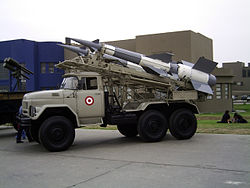Peruvian Air Force
| Peruvian Air Force | |
|---|---|
| File:PeruSu-25.jpg Peruvian Air Force Sukhoi Su-25 | |
| Active | 1950 - |
| Country | Peru |
| Part of | Ministry of Defense |
| Headquarters | The "Little" Pentagon |
| Engagements | Ecuadorian-Peruvian war Cenepa war |
| Commanders | |
| Leadership | Miguel Ángel Gómez Vizcarra (Commander-In-Chief), Fernando Villacorta Bazán (Chief of Staff) |
| Insignia | |
| Roundel |  |
| Aircraft flown | |
| Attack | A-37B, Su-25 |
| Electronic warfare | C-26B |
| Interceptor | MiG-29, Mirage 2000 |
| Reconnaissance | Lear Jet 25, Lear Jet 36 |
| Trainer | EMB-312, MB-339, Zlin 242L |
| Transport | An-32, Boeing 737, DHC-6, Falcon 20, F-28, C-130 Hercules, PC-6, Y-12 |
The Peruvian Air Force (Spanish: Fuerza Aérea del Perú, abbreviated FAP) is the branch of the Peruvian Armed Forces tasked with defending the nation and its interests through the use of air power. Additional missions include assistance in safeguarding internal security, conducting disaster relief operations and participating in international peacekeeping operations.
History
On May 20, 1929, the aviation divisions of the Peruvian Army and Navy were merged into the Cuerpo de Aviación del Perú (Peruvian Aviation Corps, abbreviated CAP). During the Colombia-Peru War of 1933, its Vought O2U Corsair and Curtiss F11 Hawk planes fought in the Amazon region. The corps was renamed Cuerpo Aeronáutico del Perú (Peruvian Aeronautical Corps, also abbreviated CAP) on March 12, 1936. In 1941, the CAP participated in the Peruvian-Ecuadorian War. At that time, the CAP were equipped with Caproni Ca.114 and North American NA.50 Torito fighters, Douglas 8A-3P attack fighters and Caproni Ca.310 Libeccio bombers,[1] among others.
During the presidency of Manuel A. Odría the corps was reorganized again and on July 18, 1950 it became the Fuerza Aérea del Perú (Air Force of Peru, abbreviated FAP). The service underwent a period of considerable expansion through out the 1970s and early 1980s which included the introduction of an important number of Soviet-made aircraft. In 1982, during the Falklands War, the Peruvian Air Force transferred ten of their Mirage 5P to the Argentine Air Force as a measure of solidarity. The economic crisis of the later 1980s forced reductions in the fleet size as well as cuts in training and general readiness.
Under those conditions the FAP fought the Cenepa War against Ecuador in 1995 and lost nine planes and helicopters. After the war, the FAP acquired new material, including MiG-29 fighters and Su-25 attack fighters which, along with Mirage 2000 fighters, are currently the main combat elements of the FAP.
Organization

The current Commander-in-Chief of the Air Force of Peru is General Miguel Ángel Gómez Vizcarra. Aerial forces are subordinated to the Ministry of Defense and ultimately to the President as Commander-in-Chief of the Peruvian Armed Forces. Operational units are organized as follows:
Ala Aérea Nº 1
1st Air Wing, headquarterd at Piura
- Grupo Aéreo Nº 6 (6th Air Group) based at Chiclayo
- Escuadrón Aéreo 612 (Fighter Squadron 612 "Cock Fighters") - operating MiG-29S/SE/UB
- Grupo Aéreo Nº 7 (7th Air Group) based at Piura
- Escuadrón Aéreo 711 (Fighter Squadron 711 "Scorpions") - operating A-37B
- Grupo Aéreo Nº 11 (11th Air Group) based at Talara
- Escuadrón Aéreo 112 (Fighter Squadron 112 "Tigers") - operating Su-25/UB

Ala Aérea Nº 2
2nd Air Wing, headquarterd at Callao
- Grupo Aéreo Nº 3 (3rd Air Group) based at Callao
- Escuadrón Aéreo 332 (Medium-Airlift Helicopter Squadron 332) - operating Mi-17
- Grupo Aéreo Nº 8 (8th Air Group) based at Callao
Ala Aérea Nº 3
3rd Air Wing, headquarterd at Arequipa
- Grupo Aéreo Nº 2 (2nd Air Group) based at Vítor
- Escuadrón Aéreo 211 (Attack Helicopter Squadron 211) - operating Mi-25D
- Grupo Aéreo Nº 4 (4th Air Group) based at La Joya
- Escuadrón Aéreo 411 (Fighter Squadron 411 "Hawks") - operating Mirage 2000P/DP
- Escuadrón Aéreo 513 (Advance Training Squadrons 513) - operating MB-339AP
- Grupo Aéreo Nº 51 (51st Air Group) based at Pisco
Ala Aérea Nº 5
5th Air Wing, headquarterd at Iquitos
- Grupo Aéreo Nº 42 (42nd Air Group) based at Iquitos
Personnel


| Personnel (as of 2001) [2] | |
|---|---|
| Commissioned Officers | 1,909 |
| Non-commissioned officers | 7,559 |
| Cadets | 325 |
| NCO in training | 296 |
| Enlisted | 7,880 |
| Civilians | 8,708 |
| Total | 17,969 (excl. civilians) |
Equipment
Numbers shown below are derived from open sources, they should be regarded as estimates due to lack of confirmation from official sources.


| Aircraft | Origin | Type | Versions | In service | Notes |
|---|---|---|---|---|---|
| English Electric Canberra | bomber aircraft | B.Mk.12/56 T.Mk.4 |
4 1 |
In storage, retired from inventory in June 14, 2008[3] | |
| Dassault Mirage 5 | attack aircraft | Mirage 5P4 Mirage 5DP4 |
10 2 |
In storage, retired from inventory in June 14, 2008[4] | |
| Sukhoi Su-22 | attack aircraft | Su-22M3 Su-22UM3 |
10 1 |
In storage | |
| Dassault Mirage 2000 | multirole fighter | Mirage 2000P Mirage 2000DP |
10 2 |
||
| Mikoyan MiG-29 | tactical fighter | MiG-29S MiG-29SE MiG-29UB |
14 3 2 |
Contract signed on August 12, 2008 for US$ 106 million with Mikoyan for a custom-made SMT upgrade of eight MiG-29S called MiG-29SMP[5] | |
| Sukhoi Su-25 | attack aircraft | Su-25 Su-25UB |
10 8 |
||
| Cessna A-37 Dragonfly | light attack aircraft | A-37B | 10 | ||
| Aermacchi MB-339 | trainer aircraft | MB-339AP | 14 | ||
| Embraer EMB 312 Tucano | trainer aircraft | EMB-312 | 18 | ||
| Zlin Z 142 | trainer aircraft | Zlin 242L | 17 | ||
| Fairchild C-26 Metroliner | ELINT | C-26B | 3 | ||
| Boeing 707 | aerial refueling transport |
707-323KC | 1 | Grounded, awaiting disposal | |
| Boeing 737 | transport transport VIP transport |
737-200 737-300 737-500 |
2 3 1 |
||
| Douglas DC-8 | transport | DC-8-62CF | 1 | Grounded, awaiting disposal | |
| Lockheed C-130 Hercules | transport | L-100-20 | 5 | 2 in storage | |
| Antonov An-32 | transport | An-32B | 5 | ||
| Harbin Y-12 | transport | Y-12 II | 5 | ||
| Dassault Falcon 20 | VIP transport | Falcon 20F | 1 | ||
| Fokker F-28 Fellowship | transport | F-28 | 1 | ||
| de Havilland Canada DHC-6 Twin Otter | utility aircraft seaplane |
DHC-6 | 5 | ||
| Lear Jet 25 | light transport reconnaissance |
Lear Jet 25B | 2 | ||
| Lear Jet 36 | light transport reconnaissance |
Lear Jet 36A | 2 | ||
| Pilatus PC-6 | liaison | PC-6 | 9 | ||
| Mil Mi-17 | transport helicopter | Mi-17 | 14 | 5 under major overhaul in SPARC, Russia | |
| Mil Mi-24 | attack helicopter | Mi-25D | 16 | At least 5 operational | |
| Bell 212 | utility helicopter | Bell 212 | 6 | ||
| Bell 412 | utility helicopter | Bell 412EP | 1 | Originally 2, second unit fate is unknown | |
| Bölkow Bo 105 | utility helicopter | Bo-105LS | 5 | ||
| Schweizer 300 | utility helicopter | Schweizer 300C | 6 |
Notes
- ^ Acig.org: The Most Powerful Air Force in Latin America
- ^ http://www.resdal.org/art-rial.htm, based on Supreme Decree DS No. 69 DE/SG of 2001.
- ^ Supreme Decree No. 009-2008-DE/FAP. June 14, 2008.
- ^ Supreme Decree No. 010-2008-DE/FAP. June 14, 2008.
- ^ FUERZA AÉRA DEL PERÚ FIRMA CONTRATO PARA REPARAR MIG29. Ministry of Defense (2008-08-12). Retrieved on 2008-08-13.
Sources
- Cobas, Efraín, Las Fuerzas Armadas Peruanas en el Siglo XXI. CESLA, 2003.
- Marchessini, Alejo, "La Fuerza Aérea del Perú"; Defensa 295: 30-42 (November 2002).
- Marchessini, Alejo, "La aviación de combate de origen ruso de la FAP"; Defensa 342: 34-36 (October 2006).
- Marchessini, Alejo, "El Servicio de Material de Guerra de la FAP"; Defensa 355: 48-50 (November 2007).

